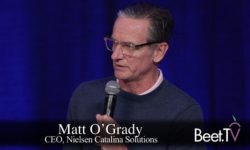SAN JUAN, Puerto Rico—Fully IP-based television may be inevitable, but fully programmatic buying and selling of advertising inventory isn’t, according to buy- and sell-side executives who converged for a panel discussion at the recent Beet Retreat 2018.
Moderated by consultant Matt Prohaska, the discussion touched on the eternal reality of supply versus demand in making sales decisions, along with the prospects for the OpenAP audience targeting consortium.
“We still have bifurcation in linear programmatic and digital, so that’s always something that we have to navigate,” said FOX’s Noah Levine. “We’ve seen a maturity begin to develop in the linear programmatic TV space, which is quite nice.”
From the sell-side, programmatic is “primarily about automating the buy and being able to empower the agency, the buyer, to do more. That’s a good thing for us as sellers,” Levine added.
“The fact that we still need to look at linear programmatic as kind of a separate beast is something we should all start to want to reconcile and maybe have some degree of concern about,” said Brett Hurwitz of OATH, the Verizon unit. And if all TV inventory becomes available on an IP-based delivery platform, a major concern will be getting “enough of a premium on the highly desirable target folks to make up for the fact that some of your other impressions are going to probably be going at a much lower price.”
The issue of brand safety still holds sway and stands in the way of 100% data-driven decisions, according to Mike Law of Dentsu Aegis Network. “We need to find the right balance of that, because some brands hold that way too close to them and some buyers hold that way too close to them,” said Law. “They fear that if I don’t say something then this computer will do my job for me or somebody will do it for me.”
Sellers have obvious concerns about total automation when optimizing their inventory across the multitude of buyers. “In linear, there’s a lot of pressure on the inventory. There’s a huge amount of demand,” said Levine.
“It’s true, the private marketplaces are really the path forward for the most part when it comes to especially linear television inventory,” said Hurwitz.
Given some marketers’ desire to cherry pick ad units versus having the ability to transact via automation, “There’s a very healthy tension between those two models that we’re seeing in the marketplace,” Levine noted. And while being able to leverage programmatic technology to access inventory and re-optimize plans “is a very desirable state for us to reach in the future,” it’s tough to do for sellers that don’t have lots of unsold inventory. “That’s one of the challenges.”
Asked by Prohaska about the prospects of the OpenAP targeting consortium launched by FOX, Viacom and Turner, Law said its premise “remains really strong and positive.” The missing piece to him is being able to transact collectively across all members.
And OpenAP is in a crowded space.
“There’s OpenAP and then I’ve got actually all the partners included in OpenAP trying to sell me their own platform, plus fifteen other networks trying to sell me their platform as well,” said Law. “And then I’ve got Simulmedia calling me, I’ve got Adobe calling me, I’ve got Videology calling me.”
OATH experienced its own version of too many choices upon the merger of AOL and Yahoo, Hurwitz recalled, given the existence of “I’m going to say eight DSP’s between the two companies” plus a number of DSP’s. OATH decided to sunset its linear TV programmatic platform, which Hurwitz called “a fantastic product,” because “we felt was going to serve the industry for some period of time and then perhaps not be the tool the industry needed.”
This video was produced in San Juan, Puerto Rico at the Beet.TV executive retreat. Please find more videos from the series on this page. The Beet Retreat was presented by NCC along with Amobee, Dish Media, Oath and Google.














































